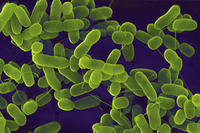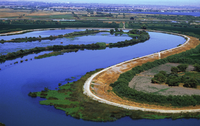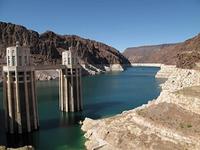-
Floating sensors to monitor water systems

The Floating Sensor Network project at UC Berkeley is building a water monitoring system that can be deployed in estuarine environments and rivers, and can be integrated into existing water-monitoring infrastructure
-
-
The American West running low on water
The American West has a drinking problem; on farms and in cities, people who live in that region are guzzling water at an alarming rate; scientists say that to live sustainably, they should use no more than 40 percent of the water from the Colorado River Basin; currently, however, they use 76 percent, nearly double the sustainable benchmark
-
-
Little of Earth’s water is usable in everyday life
Very little of Earth’s water is usable in everyday life; about 96 percent of water on Earth is saline; of the total freshwater, over 68 percent is locked up in ice and glaciers; another 30 percent of freshwater is in the ground; rivers are the source of most of the fresh surface water people use, but they only constitute about 300 mi3 (1,250 km3), about 1/10,000th of one percent of total water
-
-
Clean drinking water for everyone, everywhere
Nearly 80 percent of disease in developing countries is linked to bad water and sanitation; now scientists have developed a simple, cheap way to make water safe to drink, even if it is muddy
-
-
Rapid test strips detect swimming water contamination

Water-testing technology has never been fast enough to keep up with changing conditions, nor accessible enough to check all waters; researchers have developed a rapid testing method using a simple paper strip that can detect E. coli in water within minutes; the new tool can close the gap between outbreak and detection, improving public safety
-
-
Himalayan glaciers decline less rapidly than previously feared
Several hundreds of millions of people in Southeast Asia depend, to varying degrees, on the freshwater reservoirs of the Himalayan glaciers; it is thus important to detect the potential impact of climate changes on the Himalayan glaciers at an early stage; together with international researchers, glaciologists from the University of Zurich now show that the glaciers in the Himalayas are declining less rapidly than was previously thought; the scientists, however, see major hazard potential from outbursts of glacial lakes
-
-
Direct drinking water recycling could prevent floods
The use of a more streamlined process to recycle wastewater could have saved Brisbane from severe flooding in 2011 and mitigated recent flood risks in NSW, a leading water expert says
-
-
Most states in U.S. unprepared for growing water threats to economy, health
Only nine states in the United States have taken comprehensive steps to address their vulnerabilities to the water-related consequences of changes in climate — rainfall events which increase flooding risks to property and health change, and drought conditions which threaten supply for municipalities, agriculture, and industries — while twenty-nine states are unprepared for growing water threats to their economies and public health
-
-
Water scarcity in California's Bay-Delta necessitates “hard decisions”

Simultaneously attaining a reliable water supply for California and protecting and rehabilitating its Bay-Delta ecosystem cannot be realized until better planning can identify how trade-offs between these two goals will be managed when water is limited
-
-
Harvesting energy, water from human waste
Researchers begin developing prototype device for harvesting energy and clean drinking water from human waste; the device proposal beat more than 2,000 other proposals to receive funding from the Bill and Melinda Gates Foundation
-
-
Increase in groundwater demands due to climate change
As precipitation becomes less frequent due to climate change, lake and reservoir levels will drop and people will increasingly turn to groundwater for agricultural, industrial, and drinking water needs; the resource accounts for nearly half of all drinking water worldwide, but recharges at a much slower rate than aboveground water sources and in many cases is nonrenewable
-
-
Poultry feathers-based filters remove arsenic from water
Thousands of people die each year in developing countries from drinking arsenic-contaminated water; researchers develop inexpensive filters made from the modified protein (keratin) in poultry feathers to remove arsenic from drinking water
-
-
U.S. water shortages loom

More than 1 in 3 counties in the United States could face a “high” or “extreme” risk of water shortages due to climate change by the middle of the twenty-first century; 7 in 10 of the more than 3,100 U.S. counties could face “some” risk of shortages of fresh water for drinking, farming, and other uses
-
-
Proposed EPA budget cuts funding from clean air and water grants
President Obama’s latest proposed budget for fiscal year 2013 cuts $105 million from the Environmental Protection Agency’s (EPA) budget, primarily from funds aimed at treating wastewater and drinking water
-
-
A nano method to clean polluted water
Decontaminating polluted waste water costs millions, but a new discovery by scientists at the University of Brighton could result in huge savings as well as delivering safer, cleaner water
-
- All
- Regional
- Water
- Biometrics
- Borders/Immig
- Business
- Cybersecurity
- Detection
- Disasters
- Government
- Infrastructure
- International
- Public health
- Public Safety
- Communication interoperabillity
- Emergency services
- Emergency medical services
- Fire
- First response
- IEDs
- Law Enforcement
- Law Enforcement Technology
- Military technology
- Nonlethal weapons
- Nuclear weapons
- Personal protection equipment
- Police
- Notification /alert systems
- Situational awareness
- Weapons systems
- Sci-Tech
- Sector Reports
- Surveillance
- Transportation
Advertising & Marketing: advertise@newswirepubs.com
Editorial: editor@newswirepubs.com
General: info@newswirepubs.com
2010-2011 © News Wire Publications, LLC News Wire Publications, LLC
220 Old Country Road | Suite 200 | Mineola | New York | 11501
Permissions and Policies
Editorial: editor@newswirepubs.com
General: info@newswirepubs.com
2010-2011 © News Wire Publications, LLC News Wire Publications, LLC
220 Old Country Road | Suite 200 | Mineola | New York | 11501
Permissions and Policies
